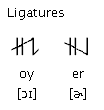
Ewellic alphabet charts

 |
Ewellic alphabet charts |
 |
Here are some charts showing the letters, digits, and ligatures of the Ewellic alphabet. There are 66 characters in all, not including ligatures. Each letter is shown with its name and approximate IPA (International Phonetic Alphabet) pronunciation. Letters in red are not generally used for writing English words.
These are the consonants and vowels. Words of more than one syllable must include an acute accent over the vowel of the syllable that receives the primary stress. (In Unicode terms, this is a combining mark.) Only unusually long compound words should ever have more than one accent.

|

|
Can’t find the letter you’re looking for? In Ewellic, affricate consonants like the ch sound in “church” or the j sound in “judge” are represented as two letters—t + sh and d + zh respectively—because they really are two sounds, if you think about it. Likewise, diphthongs like the i in “ice” and the ow in “cow” are represented as aa + y and aa + w respectively, because each is really two sounds gliding into one another, not a single atomic sound. (Note that many linguists do consider affricates and diphthongs to be single sounds, and many writing systems—both “natural” and constructed—do represent them with single letters.)
Remember that Ewellic is a phonemic alphabet, not a cipher for the Latin script. Words are spelled the way they sound to the writer, which means spelling is not as stable as in Latin-script orthography. A word like “laugh” would be spelled l + a + f by a typical American English speaker, and l + aa + f by a typical British English speaker. There is no u, no g, and no h.
Ligatures may be formed by linking two (or more) letters at what I call “natural connection points.” The two ligatures shown below are traditional, and should be rendered whenever possible. (The sample texts on this site don’t include ligatures because of limitations in fonts and rendering systems, but I always use them in handwritten Ewellic text.) Other ligatures may be formed using the same principles; the combination aw + t (as in “ought”) is an example.

|
The following digits can be used to represent either decimal or hexadecimal numbers. Only the digits 0 through 9 are valid for decimal numbers, of course. A hexadecimal number is always preceded by a grave accent (spacing mark) to distinguish it from a decimal number. This means there is no need for notations like “0x1234”, “1234h”, “123416”, or “1234 (hex)”.

|
If you have any questions or comments about the Ewellic alphabet, please
contact me.
Yes, I do accept e-mails in Ewellic. :-)
| Copyright © 2003–2013 by Doug Ewell • Last modified 2019-08-03 |
|
|
|